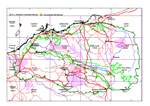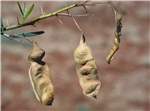Click on images
to enlarge


, 20 km W of Mt Magnet, BRM 13 Oct 1999, ORIGINAL_sml.jpg)
Photographer: B.R. Maslin
 & synchronicia (right), ADJUSTED RICHARD WOODMAN_sml.jpg)
Acacia victoriae (right) and A. synchronicia (left). Photographer: B.R. Maslin
, BRM 7940, ORIGINAL SCAN, ADJUSTED RICHARD WOODMAN_sml.jpg)
Photographer: B.R. Maslin

Spiny stipules persistent on stems. Photographer: B.R. Maslin

Photographer: B.R. Maslin

Photographer: B.R. Maslin
 pods (J. Morse) [FloraSearch modified], ADJUSTED_sml.jpg)
Photographer: J. Morse

Photographer: B.R. Maslin
, BRM 8714, lab photo by Fiona McCallum ADJUSTED_sml.jpg)
Seed from one herbarium voucher. Scale in mm. Photographer: F. McCallum.
Botanical name
Acacia victoriae Benth. in T.L.Mitchell, J. Exped. Trop. Australia 333 (1848)
Common name
Elegant Wattle (preferred common name), Gundabluey, Bramble Wattle, Prickly Wattle, and more
Aboriginal name
Thambarli (Banyjima)
Description
Much-branched, sturdy, often straggly and brambly, usually glabrous shrubs or small trees 1.5-3.5 m tall (can reach up to 5 m, or exceptionally 9 m tall, outside the Pilbara), with a short single trunk or sparingly divided at ground level, main stems somewhat crooked and commonly about 6 cm diameter at breast height, readily root suckering and sometimes forming thickets. Bark grey and finely longitudinally fissured at base of main stems or mature plants, smooth and greenish or light bronze on upper branches, stems of young plants green. Branchlets yellow-green or (especially when young) pruinose. New shoots light green. Stipules spiny, 2-12 mm long, especially evident on young plants but commonly absent from mature plants. Phyllodes variable, linear to narrowly oblong, lanceolate or narrowly elliptic, usually (1.5-) 2-6.5 cm long and 2-9 mm wide with l:w = 2-13, smooth, straight or incurved, sub-glaucous or glaucous (sometimes with a pruinose surface bloom ) or green to grey-green; midrib rather prominent when dry (but scarcely visible on fresh phyllodes); apex not spiny. Gland obscure or prominent, situated on upper margin of phyllode at distal end of pulvinus. Inflorescences mostly racemose but peduncles sometimes subtended by a secondary phyllode; raceme axes 1-10 cm long, slender; peduncles mostly twinned, 6-18 mm long, slender; heads prolific, globular, creamy white to pale lemon-yellow, 15-30-flowered. Flowers 5-merous; sepals free, narrowly spathulate. Pods narrowly oblong, flat but rounded over seeds along midline, straight-edged, 3-6 (-8) cm long, 9-16 mm wide, papery, straight to slightly curved. Seeds transverse in the pods, globose, 4-6 mm long, brown but mottled blackish; funicle short, thick, scarcely arillate.
Characteristic features
Much-branched, sturdy, often straggly and brambly, usually glabrous shrubs or small trees, upper branches greenish or light bronze, readily root suckering and sometimes forming thickets. Branchlets sometimes pruinose (especially when young). Stipules spiny, especially evident on young plants but commonly absent from mature plants. Phyllodes variable, linear to narrowly oblong, lanceolate or narrowly elliptic, straight or incurved, relatively short and narrow (mostly 2-6.5 cm x 2-9 mm with l:w = 2-13), green to grey-green, sub-glaucous or glaucous, sometimes pruinose, midrib rather prominent when dry. Inflorescences mostly racemes (1-10 cm long); heads prolific, 15-30-flowered, creamy white to pale lemon-yellow. Pods narrowly oblong, papery, flat but rounded over seeds along midline. Seeds transverse, globose, brown but mottled blackish; funicle short, thick, scarcely arillate.
Distribution and ecology
Widespread in arid and sub- tropical areas of all mainland states of Australia except Victoria (where it is confined to the extreme northwest of that state). Over its extensive range A. victoriae occurs in a variety of habitats but is commonly found in clay or loam on alluvial flats. Soils range from acid to alkaline or sub- saline, and shallow to deep. Acacia victoriae is not especially common in the Pilbara where it grows in clay along floodways with A. aneura or A. xiphophylla as frequent associates. On Mt Florance (north of Wittenoom) A. victoriae grows with its close relative, A. synchronicia (which is more common in the Pilbara: see A. synchronicia for discussion of differences). In some areas throughout its geographic range the numbers of plants of A. victoriae may increase markedly during a succession of wet seasons and the species can become a nuisance, especially around watering points, but (in the Pilbara at least) not to the same extent as A. synchronicia.
Flowering and fruiting period
Flowering occurs from (July) August to November (December) and appears to vary depending upon where the plants occur. Although flowering is sometimes irregular it does not appear to be dependent upon the incidence of rain. Most sources record mature seeds occurring between about October and December, although they have also been recorded for August to October and November to March. Pods are produced in great profusion and are easily collected by hand (shaking/threshing); they may be shed unopened or may open on the plant with the seeds remaining attached by the funicle.
Variation
The Pilbara plants of A. victoriae are normally glabrous, however, very occasionally the branchlets have fine, wide-spreading sparse hairs.
Taxonomy
Recently Ariati et al. (2007) recognized three subspecies within A. victoriae, subsp. arida, subsp. fasciaria and subsp. victoriae. Only the latter subspecies occurs in the Pilbara and is referred to herein as A. victoriae.
Affinities
This species is a member of the 'A. victoriae group' (see Maslin 1992 for discussion); other members of this group which occur in the Pilbara include A. aphanoclada, A. cuspidifolia, A. glaucocaesia, A. robeorum and A. synchronicia. In the absence of flowers A. victoriae may be confused with the typical variant of A. synchronicia (see that species for distinguishing characters).
Notes
Acacia victoriae is a primary colonizer on degraded land and, as summarized by Maslin and McDonald (2004), it is an adaptable species that is fast-growing, relatively short-lived (probably has a life-span of about 10-15 years) and moderately frost tolerant. It readily root suckers and has a large root system.
It is useful as a low windbreak and for soil stabilisation in dry country, especially as it can readily regenerate from suckers and sometimes forms thickets. As noted under Distribution and ecology this species is sometimes a nuisance, especially around watering points.
Acacia victoriae has moderate nutritive value and is a useful stock food supplement during less severe drought but, in Northern Territory at least, dies out quickly in a severe drought; it recovers well after light grazing and is moderately fire tolerant when young (Askew and Mitchell 1978). The phyllodes have moderate palatability and digestibility although foliage is usually not produced in particularly large amounts, and the seeds are a good source of protein for cattle.
This species is the one most commonly used as a human food in the Bush Tucker industry (see Maslin et al. 1998).
There is a considerable amount of information published for A. victoriae and an introduction to this literature is provided by Turnbull (1986), Doran and Turnbull (1997) and Maslin and McDonald (2004).
Conservation status
Not considered rare or endangered.
Origin of name
Thomas Livingstone Mitchell, Surveyor-General of NSW, explored central Queensland from November 1845 to January 1847 and named the 'Victoria' river after Queen Victoria. George Bentham named this species after the river where it was found by Mitchell in 1846. The river has since been renamed the Barcoo.
References
Ariati, S.R., Murphy, D.J., Gardner, S. and Ladiges, P.Y. (2007). Morphological and genetic variation within the widespread species Acacia victoriae (Mimosaceae). Australian Systematic Botany 20: 54-62.
Askew, K. and Mitchell, A.S. (1978). The fodder trees and shrubs of the Northern Territory. Extension bulletin No. 16. pp. 84. (CSIRO Division of Primary Industry: Alice Springs.)
Doran, J.C. and Turnbull, J.W. (1997). Australian trees and shrubs: species for land rehabilitation and farm planting in the tropics. ACIAR Monograph No. 24. pp. 384. (Australian Centre for International Agricultural Research: Canberra.)
Maslin, B.R. (1992). Acacia Miscellany 6. A review of Acacia victoriae and related species (Leguminosae: Mimosoideae: Section Phyllodineae). Nuytsia 8: 285-309.
Maslin, B.R. and McDonald, M.W. (2004). AcaciaSearch: Evaluation of Acacia as a woody crop option for southern Australia. RIRDC Publication No. 03/017. pp. 267. (Rural Industries Research and Development Corporation: Canberra.)
Maslin, B.R., Thomson, L.A.J., McDonald, M.W. and Hamilton-Brown, S. (1998). Edible Wattle Seeds of Southern Australia: A review of species for use in semi-arid regions. pp. 108. (CSIRO Publishing: Collingwood, Victoria.)
Turnbull, J.W. (ed.) (1986). Multipurpose Australian trees and shrubs: lesser-known species for fuelwood and agroforestry. pp. 316. (Australian Centre for International Agricultural Research: Canberra.)
